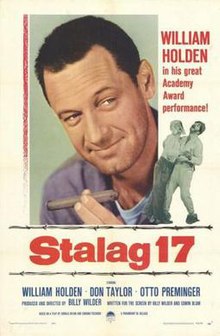
Billy Wilder was an Austrian-born filmmaker and screenwriter. His career in Hollywood spanned five decades, and he is regarded as one of the most brilliant and versatile filmmakers of Classic Hollywood cinema. He received seven Academy Awards, a BAFTA Award, the Cannes Film Festival's Palme d'Or and two Golden Globe Awards.

Hogan's Heroes is an American television sitcom set in a prisoner-of-war (POW) camp in Nazi Germany during World War II, which concerns a group of Allied prisoners who use the POW camp as an operations base for sabotage and espionage purposes directed against Nazi Germany. It ran for 168 episodes from September 17, 1965, to April 4, 1971, on the CBS network, the longest broadcast run for an American television series inspired by that war.

William Franklin Holden was an American actor and one of the biggest box-office draws of the 1950s. Holden won the Academy Award for Best Actor for the film Stalag 17 (1953) and the Primetime Emmy Award for Outstanding Lead Actor in a Limited or Anthology Series or Movie for the television miniseries The Blue Knight (1973).
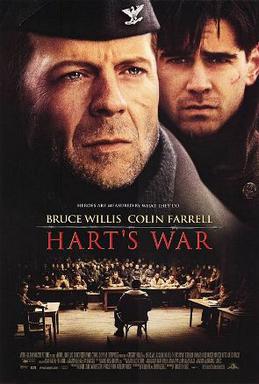
Hart's War is a 2002 American war drama film about a World War II prisoner of war (POW) camp based on the novel by John Katzenbach. It stars Bruce Willis as Col. William McNamara and Colin Farrell as Lt. Thomas Hart. The film co-stars Terrence Howard, Cole Hauser, and Marcel Iureş. Directed by Gregory Hoblit, the film was shot at Barrandov Studios in Prague, and released on February 15, 2002. The film earned mixed reviews, grossing $33.1 million against its $70 million budget.
William Pierson was an American television, motion picture and stage actor, best known for his raspy voice and his role as Marko the Mailman in the 1953 film Stalag 17 as well as a recurring role as Dean Travers on the 1970s ABC-TV series Three's Company.
Marlag und Milag Nord was a Second World War German prisoner-of-war camp complex for men of the British and Canadian Merchant Navy and Royal Navy. It was located around the village of Westertimke, about 30 km (19 mi) north-east of Bremen, though in some sources the camp's location is given as Tarmstedt, a larger village about 4 km (2.5 mi) to the west. There were also American merchant seamen detained here as well as some U.S. Navy personnel.
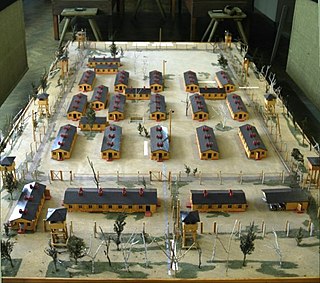
Stalag Luft III was a Luftwaffe-run prisoner-of-war (POW) camp during the Second World War, which held captured Western Allied air force personnel.

Stalag II-B was a German World War II prisoner-of-war camp situated 2.4 kilometres (1.5 mi) west of the town of Hammerstein, Pomerania on the north side of the railway line. It housed Polish, French, Belgian, Serbian, Dutch, Soviet, Italian and American prisoners of war.
A military prison is a prison operated by a military. Military prisons are used variously to house prisoners of war, unlawful combatants, those whose freedom is deemed a national security risk by the military or national authorities, and members of the military found guilty of a serious crime. There are two types: penal and confinement-oriented, where captured enemy combatants are confined for military reasons until hostilities cease. Most militaries have some sort of military police unit operating at the divisional level or below to perform many of the same functions as civilian police, from traffic-control to the arrest of violent offenders and the supervision of detainees and prisoners of war.
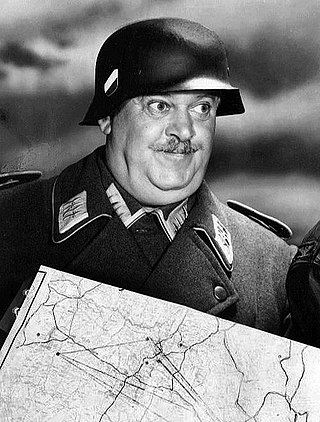
John Banner was an Austrian-born American actor, best known for his role as Sergeant Schultz in the situation comedy Hogan's Heroes (1965–1971). Schultz, constantly encountering evidence that inmates of his stalag were actively conducting anti-German espionage and sabotage activities, frequently feigned ignorance with the catchphrase, "I see nothing! I hear nothing! I know nothing!".

Harvey Lembeck was an American comedic actor best remembered for his role as Cpl. Rocco Barbella on The Phil Silvers Show in the late 1950s, and as the stumbling, overconfident quasi-outlaw biker Eric Von Zipper in beach party films during the 1960s. He also turned in noteworthy performances in both the stage and screen versions of Stalag 17. He was the father of actor and director Michael Lembeck and actress Helaine Lembeck.

Stalag XI-B and Stalag XI-D / 357 were two German World War II prisoner-of-war camps (Stammlager) located just to the east of the town of Fallingbostel in Lower Saxony, in north-western Germany. The camps housed Polish, French, Belgian, Soviet, Italian, British, Yugoslav, American, Canadian, New Zealander and other Allied POWs.
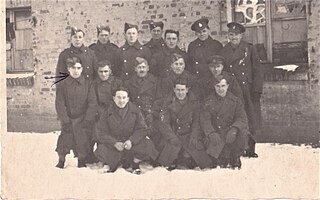
Stalag VIII-B was a German Army prisoner-of-war camp during World War II, later renumbered Stalag-344, located near the village of Lamsdorf in Silesia. The camp initially occupied barracks built to house British and French prisoners in World War I. At this same location there had been a prisoner camp during the Franco-Prussian War of 1870-71.

Donald Ritchie Taylor was an American actor and film director. He co-starred in 1940s and 1950s classics, including the 1948 film noir The Naked City, Battleground, Father of the Bride, Father's Little Dividend and Stalag 17. He later turned to directing films such as Escape from the Planet of the Apes (1971), Tom Sawyer (1973), Echoes of a Summer (1976), and Damien - Omen II (1978).

Stalag VII-A was the largest prisoner-of-war camp in Nazi Germany during World War II, located just north of the town of Moosburg in southern Bavaria. The camp covered an area of 35 hectares. It served also as a transit camp through which prisoners, including officers, were processed on their way to other camps. At some time during the war, prisoners from every nation fighting against Germany passed through it. At the time of its liberation on 29 April 1945, there were 76,248 prisoners in the main camp and 40,000 or more in Arbeitskommando working in factories, repairing railroads or on farms.

Richard Erdman was an American character actor and occasional film and television director. He appeared in more than 160 films and television productions between 1944 and 2017, mostly in supporting roles. He is most known for his roles in the classic films Stalag 17 (1953) and Tora! Tora! Tora! (1970). In his final years, Erdman found renewed fame through his portrayal of Leonard in the critically acclaimed comedy series Community (2009–2015).
Donald Joseph Bevan was an American playwright whose works include the Broadway play Stalag 17, co-written with Edmund Trzcinski, and adapted as a movie in 1953. He was also the caricaturist for the celebrity wall at Sardi's restaurant in New York City for over 20 years, the third of four such artists employed by Sardi's.
Edmund Trzcinski was an American playwright, best known for the play Stalag 17.
Stalag Luft I was a German World War II prisoner-of-war (POW) camp near Barth, Western Pomerania, Germany, for captured Allied airmen. The presence of the prison camp is said to have shielded the town of Barth from Allied bombing. About 9,000 airmen – 7,588 American and 1,351 British and Canadian – were imprisoned there when it was liberated on the night of 30 April 1945 by Soviet troops.

Szebnie was a forced-labor camp established during World War II by Nazi Germany in the General Government in the south-eastern part of occupied Poland. It was located near the town of Szebnie approximately 10 kilometres (6 mi) east of Jasło and 42 km (26 mi) south-west of Rzeszów. The facility was constructed in 1940 originally as horse stables for the Wehrmacht, adjacent to a manorial estate where the German officers stationed (photo). Over the course of the camp's operation thousands of people perished there, including Soviet prisoners of war, Polish Jews, Poles, Ukrainians, and Romani people. The charred remains of the camp were entered by the Soviets on 8 September 1944.
